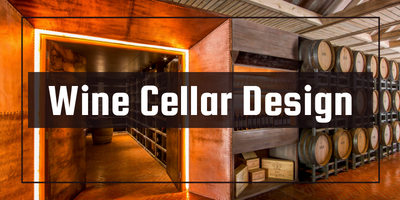
5 Signs Your Wine Cooling System Is About to Fail
Don’t wait for a costly surprise. Wine Guardian Dealer breaks down the top 5 signs your wine cooling system may be failing — and how to fix it before damage...
Jim Hopper
In Stock & Ready to Ship – Order Your Wine Cooling System Today!
Free Wine Cellar Expert Consultation | 📞 Call 1-800-260-1712
Start with a free expert consult—cooling system sizing, racking options, and no upsells.

Build your dream wine cellar—without costly mistakes or guesswork.
By Jim Hopper, Wine Cooling Expert
Proper wine cabinet installation is crucial for maintaining wine quality — ensuring optimal temperature, humidity, and ventilation from day one. Whether you’re setting up a freestanding unit or integrating a built-in wine cabinet, installation plays a key role in preserving your collection.
This step-by-step guide will walk you through the full wine storage installation process, from site preparation to positioning, electrical setup, and post-installation checks — so you can enjoy your wine collection to the fullest.
For detailed advice on choosing and customizing your unit, visit our full Wine Cabinet Guide: Compare, Customize, and Choose the Right Wine Storage Solution.

When planning your wine cabinet, setting a realistic budget is crucial to ensure your project stays on track and within financial limits. Start by considering the overall size and complexity of your wine cabinet. A small, simple unit might cost less than $1,000, while a larger, more elaborate design could extend to $5,000 or more.
Factor in the cost of materials such as wood, metal, or glass, and any specialized features you might want, like a wine fridge or climate control system. These elements can significantly impact your budget. Additionally, if you’re not planning to build the cabinet yourself, remember to include the cost of hiring a professional contractor or carpenter, which can add a lot to your expenses.
Prioritize your needs and wants to allocate your budget effectively. Determine which features are essential and which are nice-to-haves. With careful planning and attention to detail, you can create a beautiful and functional wine cabinet that meets your needs and stays within your budget.
Selecting the best place to install a wine cabinet impacts performance and longevity. Ideal spots include basements, kitchens, or dedicated wine cellars. Avoid areas with direct sunlight, heat sources, or poor ventilation. Ensure access to an appropriate power supply to prevent future issues.

Designing the interior of your wine cabinet involves several aesthetic choices that can enhance both its functionality and visual appeal. Start by selecting the materials for the shelves and walls. Wood is a popular choice for its warmth and character, while metal or glass can offer a modern, sleek look.
Consider the color scheme of your wine cabinet. It can either blend seamlessly with your existing decor or stand out as a bold statement piece. Take into account the colors of the walls, floors, and furniture in the room to choose a complementary palette.
Lighting plays a crucial role in creating the right ambiance. LED lights are an excellent choice, providing a soft, warm glow that can be adjusted to different brightness levels. This not only creates a cozy atmosphere but also highlights specific bottles or features within your cabinet.
Finally, think about the overall style of your cabinet. Whether you prefer a modern, minimalist design or a more traditional, ornate look, your choices in materials, colors, and lighting will help you achieve the desired aesthetic. By carefully considering these factors, you can design a wine cabinet that is both functional and visually stunning.
Gathering the necessary tools and materials needed beforehand makes the wine cabinet setup smoother. You’ll need:
Screwdrivers, drill, and measuring tape
Mounting brackets (for built-in units)
Level for accurate alignment
Screws and wall anchors
Dedicated power source

Measure the designated area carefully to confirm the cabinet fits. By establishing a clear outline of your space, you can easily fill in the necessary details later. Ensure the surface is flat and stable. Proper ventilation is essential to prevent overheating. If installing a wine cabinet within cabinetry, allow at least 2-3 inches of clearance for airflow.
Ensuring your wine cabinet is properly framed, insulated, and protected from moisture is essential for maintaining a stable environment for your wine collection. Start with a sturdy frame made from durable materials like wood or metal. This will support the weight of your wine bottles and any additional features, such as a wine fridge or lighting.
Insulation is key to regulating temperature and humidity within the cabinet. High-quality insulation materials, such as foam board or fiberglass, should be used to prevent temperature fluctuations and moisture ingress. Proper installation is crucial to avoid gaps or voids that could compromise the cabinet’s climate control.
A vapor barrier is another critical component. This layer of material prevents moisture from passing through the walls or ceiling of the cabinet, helping to prevent mold and mildew growth and maintain consistent humidity levels. By addressing these factors, you can create a wine cabinet that provides a safe, controlled environment for your wine collection, ensuring it remains in optimal condition for years to come.
Upon delivery, inspect your wine cabinet for damage. Verify that all parts, including shelves, screws, and brackets, are included. Read the manufacturer’s guide for model-specific instructions.
Carefully move the wine cabinet to its intended location. Use a level to ensure it sits evenly on the floor or within cabinetry. An unlevel wine storage unit may cause wine bottles to be imbalanced and compromise temperature control.
For built-in wine cabinet installation, attach the cabinet to the cabinetry or wall using mounting brackets. Secure with screws and wall anchors to prevent tipping. Freestanding models do not require this step.
Plug the wine cabinet cooling system into a dedicated power outlet. Avoid using extension cords, as they may cause voltage fluctuations and affect the ability to regulate temperature effectively. Set the ideal temperature (typically 55°F) and adjust wine storage humidity control to maintain optimal storage conditions.
Organize wine bottles strategically for optimal air circulation. Ensure that the storage conditions meet the specific requirements for cork-sealed bottles to maintain their quality. Store corked bottles horizontally to maintain cork moisture and prevent oxidation. Avoid overloading, as proper airflow is crucial for consistent cooling.
To prevent electrical hazards, ensure your outlet supports the required voltage. Avoid overloading circuits. If mounting a heavy cabinet, confirm wall or cabinetry stability to prevent accidents. Always keep the installation area well-ventilated.

Placing the wine cabinet near heat sources can create a problem with maintaining optimal temperature
Blocking ventilation areas
Uneven positioning causing vibration
Adjust wine cabinet placement for optimal airflow
Secure wine cabinet to prevent excess movement
Check power connections and settings
A well-organized wine cabinet enhances storage efficiency. Consider:
Built-in vs. freestanding wine cabinets based on available space
Adjusting temperature control for different wines
Optimizing wine rack layout for maximum bottle capacity
Organizing your wine cabinet can also be a fun process, allowing you to personalize your storage space creatively.
At Wine Guardian Dealer, we understand the importance of reliable and high-quality wine storage solutions. As an authorized dealer of Wine Guardian, we offer an extensive range of premium wine cooling units designed to maintain the ideal environment for your wine collection. Our systems ensure that your wine collection is stored under optimal conditions throughout the year.
Why choose us?
Expert Guidance: Our team helps you select the best cooling unit tailored to your needs.
Top-Tier Products: We provide industry-leading Wine Guardian cooling systems for superior performance and quiet operation.
Customer-Centric Service: From purchase to wine cellar service, we ensure a seamless experience with Wine Guardian tech support.
Upgrade your wine storage with the best in the industry. Explore our collection at Wine Guardian Dealer and find the perfect cooling unit for your wine cabinet today!
A properly installed wine cabinet ensures optimal storage conditions. Follow these steps to achieve efficient wine storage installation. If in doubt, consult a trusted distributor.
Ensure at least 2-3 inches of clearance around the cabinet for ventilation.
Yes, compact and freestanding models work well in small spaces.
Most wines store best at around 55°F with 50-70% humidity control.
🛒Shop our most-loved Wine Guardian cooling systems today.
🛠️Protect your wine with the most trusted systems on the market.
❤️Tested, reviewed, and loved by serious collectors like you.